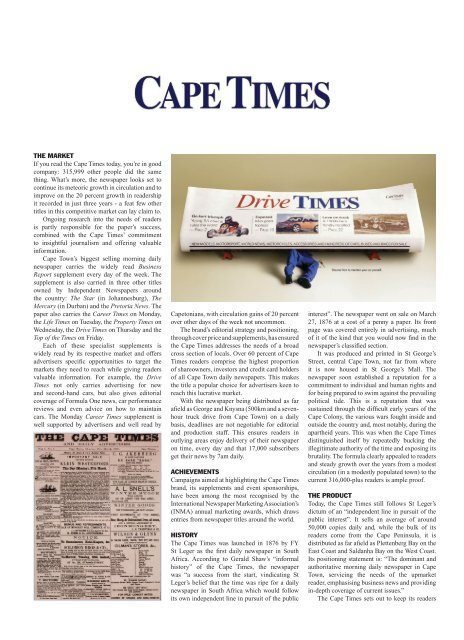South Africa Edition 2
Create successful ePaper yourself
Turn your PDF publications into a flip-book with our unique Google optimized e-Paper software.
THE MARKET<br />
If you read the Cape Times today, you’re in good<br />
company: 315,999 other people did the same<br />
thing. What’s more, the newspaper looks set to<br />
continue its meteoric growth in circulation and to<br />
improve on the 20 percent growth in readership<br />
it recorded in just three years - a feat few other<br />
titles in this competitive market can lay claim to.<br />
Ongoing research into the needs of readers<br />
is partly responsible for the paper’s success,<br />
combined with the Cape Times’ commitment<br />
to insightful journalism and offering valuable<br />
information.<br />
Cape Town’s biggest selling morning daily<br />
newspaper carries the widely read Business<br />
Report supplement every day of the week. The<br />
supplement is also carried in three other titles<br />
owned by Independent Newspapers around<br />
the country: The Star (in Johannesburg), The<br />
Mercury (in Durban) and the Pretoria News. The<br />
paper also carries the Career Times on Monday,<br />
the Life Times on Tuesday, the Property Times on<br />
Wednesday, the Drive Times on Thursday and the<br />
Top of the Times on Friday.<br />
Each of these specialist supplements is<br />
widely read by its respective market and offers<br />
advertisers specific opportunities to target the<br />
markets they need to reach while giving readers<br />
valuable information. For example, the Drive<br />
Times not only carries advertising for new<br />
and second-hand cars, but also gives editorial<br />
coverage of Formula One news, car performance<br />
reviews and even advice on how to maintain<br />
cars. The Monday Career Times supplement is<br />
well supported by advertisers and well read by<br />
Capetonians, with circulation gains of 20 percent<br />
over other days of the week not uncommon.<br />
The brand’s editorial strategy and positioning,<br />
through cover price and supplements, has ensured<br />
the Cape Times addresses the needs of a broad<br />
cross section of locals. Over 60 percent of Cape<br />
Times readers comprise the highest proportion<br />
of shareowners, investors and credit card holders<br />
of all Cape Town daily newspapers. This makes<br />
the title a popular choice for advertisers keen to<br />
reach this lucrative market.<br />
With the newspaper being distributed as far<br />
afield as George and Knysna (500km and a sevenhour<br />
truck drive from Cape Town) on a daily<br />
basis, deadlines are not negotiable for editorial<br />
and production staff. This ensures readers in<br />
outlying areas enjoy delivery of their newspaper<br />
on time, every day and that 17,000 subscribers<br />
get their news by 7am daily.<br />
ACHIEVEMENTS<br />
Campaigns aimed at highlighting the Cape Times<br />
brand, its supplements and event sponsorships,<br />
have been among the most recognised by the<br />
International Newspaper Marketing Association’s<br />
(INMA) annual marketing awards, which draws<br />
entries from newspaper titles around the world.<br />
HISTORY<br />
The Cape Times was launched in 1876 by FY<br />
St Leger as the first daily newspaper in <strong>South</strong><br />
<strong>Africa</strong>. According to Gerald Shaw’s “informal<br />
history” of the Cape Times, the newspaper<br />
was “a success from the start, vindicating St<br />
Leger’s belief that the time was ripe for a daily<br />
newspaper in <strong>South</strong> <strong>Africa</strong> which would follow<br />
its own independent line in pursuit of the public<br />
interest”. The newspaper went on sale on March<br />
27, 1876 at a cost of a penny a paper. Its front<br />
page was covered entirely in advertising, much<br />
of it of the kind that you would now find in the<br />
newspaper’s classified section.<br />
It was produced and printed in St George’s<br />
Street, central Cape Town, not far from where<br />
it is now housed in St George’s Mall. The<br />
newspaper soon established a reputation for a<br />
commitment to individual and human rights and<br />
for being prepared to swim against the prevailing<br />
political tide. This is a reputation that was<br />
sustained through the difficult early years of the<br />
Cape Colony, the various wars fought inside and<br />
outside the country and, most notably, during the<br />
apartheid years. This was when the Cape Times<br />
distinguished itself by repeatedly bucking the<br />
illegitimate authority of the time and exposing its<br />
brutality. The formula clearly appealed to readers<br />
and steady growth over the years from a modest<br />
circulation (in a modestly populated town) to the<br />
current 316,000-plus readers is ample proof.<br />
THE PRODUCT<br />
Today, the Cape Times still follows St Leger’s<br />
dictum of an “independent line in pursuit of the<br />
public interest”. It sells an average of around<br />
50,000 copies daily and, while the bulk of its<br />
readers come from the Cape Peninsula, it is<br />
distributed as far afield as Plettenberg Bay on the<br />
East Coast and Saldanha Bay on the West Coast.<br />
Its positioning statement is: “The dominant and<br />
authoritative morning daily newspaper in Cape<br />
Town, servicing the needs of the upmarket<br />
reader, emphasising business news and providing<br />
in-depth coverage of current issues.”<br />
The Cape Times sets out to keep its readers

















